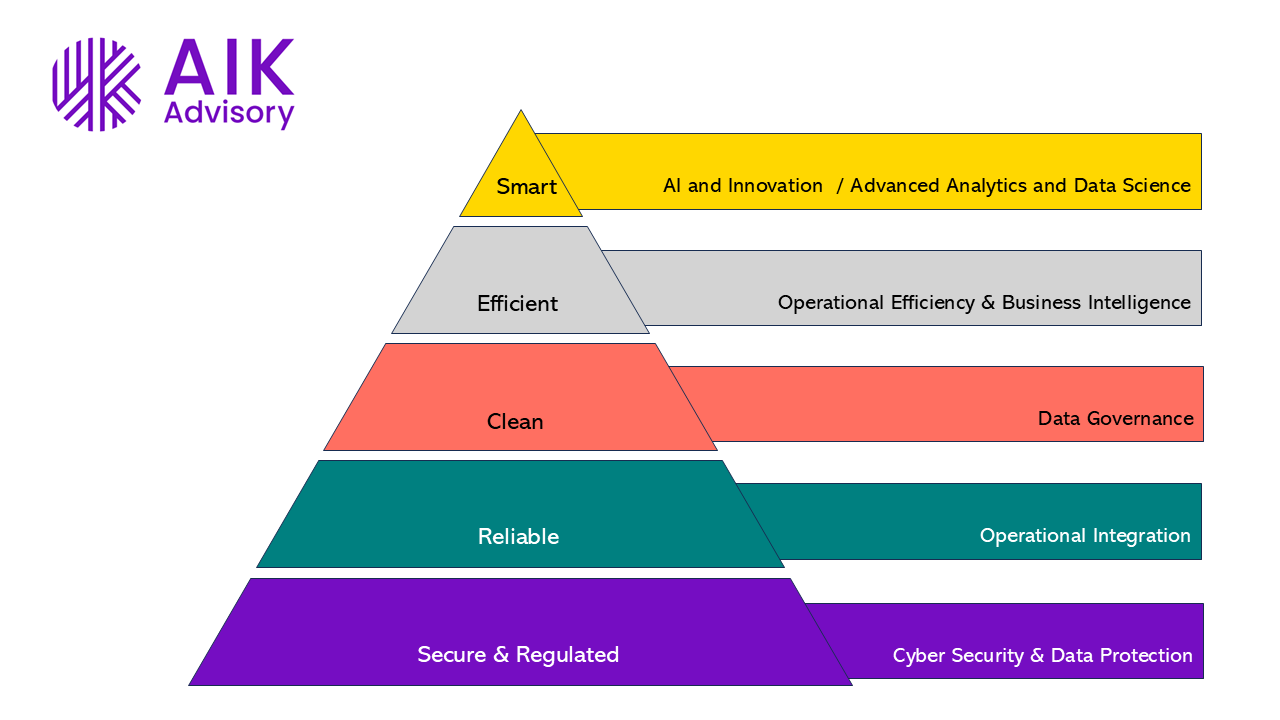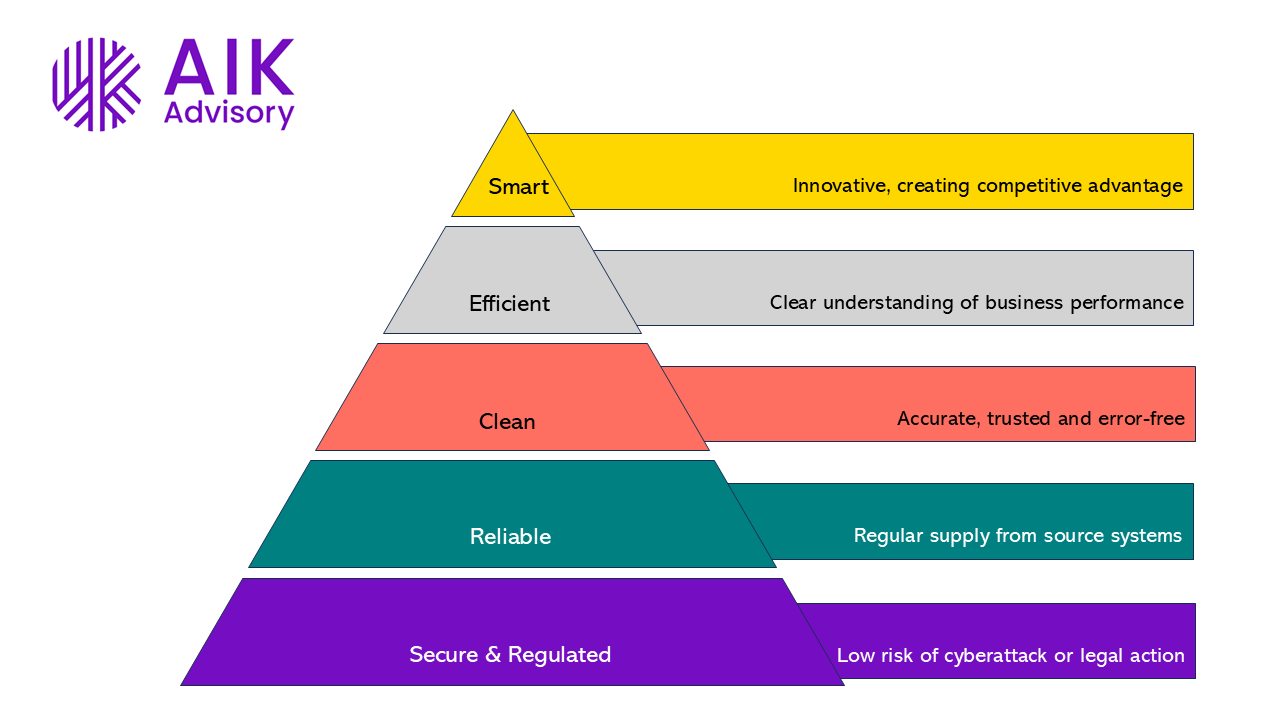The Hierarchy of Data Needs
Introduction
I’ve had numerous discussions with respected industry professionals and we wonder how we can rebrand Data Governance as an essential business priority. These days, Data Governance often stands on the side-lines, watching AI steal the spotlight, quietly reminding everyone, "But what about data quality?"
It's not that businesses don’t care; they’re just more focused on trends and technologies that they believe will drive massive benefits. This is not just the situation for Data Governance, it extends to other areas too.
How do you do smart and do reliable?
Recently, I met with a potential client who thought I was wanted to discuss Cyber Security. They weren’t really interested in that but kindly gave me a significant amount of their time anyway.
I explained that while I could certainly talk about Cyber Security, what I really wanted to introduce them to, was the Hierarchy of Data Needs - a concept I’ve been developing to simplify the complexities of Data Management into a clear, structured framework.
It shares similarities with Maslow’s Hierarchy of Needs, but with a few twists. As you ascend the pyramid, you progress from the basics of data security and data protection to the pinnacle of advanced analytics and AI.
The model is straightforward to describe, yet implementing each layer can involve significant complexity.
Working up the hierarchy from bottom to top we find the following:
1. Foundational Layer: Cyber Security & Data Protection
The base of the pyramid is Cyber Security and Data Protection, both crucial for maintaining a secure and compliant data environment. Without this solid foundation, businesses risk data breaches, compliance violations, and significant disruptions.
Key Focus: Safeguarding data from unauthorised access, data breaches, and ensuring compliance with data privacy regulations.
Key Insight: Robust Cyber Security and Data Protection are essential to mitigate risks and ensure a secure environment for all data-related activities.
General approach: Low level technical activities which mitigate high risk impacts.
2. Operational Integration
This layer focuses enabling data flows through various operational systems. It’s where Data Architects and Data Engineers work to ensure data reliability, consistency, and provenance. This is about integrating data sources efficiently so that information is accessible, dependable, and clearly traceable back to its origin.
Key Focus: Reliable data collection and processing, maintaining data integrity and clear provenance.
Key Insight: Operational integration provides the basis for consistent data flow and ensures data is regularly and predictably available, forming a stable base for higher-level processes.
General approach: Technical focus creating well developed and efficient data operations.
3. Data Governance
Moving up the hierarchy, Data Governance ensures that data is not only available but also clean, accurate, and trusted. It involves data stewardship, clear data definitions, and enforcing business processes to maintain data quality across the organization. This is the layer where data starts becoming visible to business users as a trustworthy resource.
Key Focus: Data quality, data lineage, data stewardship within the user communities and accessibility. Key metrics include coverage, accuracy, and availability.
Key Insight: Effective Data Governance ensures that data is clean and dependable, creating a stable platform for more sophisticated insights and analytics.
General approach: A business-related focus that allows the value of good quality reliable data to be recognised.
4. Operational Efficiency through Business Intelligence
This layer is where businesses begin to reap the benefits of their investment in data management. Clean and reliable data supports Business Intelligence (BI), allows organisations to improve operational efficiency through making informed decisions, monitoring performance, and optimising processes.
Key Focus: Reporting, dashboards, performance metrics, and operational analytics that enable better decision-making.
Key Insight: Accurate and timely management information builds trust, reducing the risk of alternative data solutions and enabling smooth operational processes.
General approach: Business Users using the information to deliver operational insight to inform and improve the business performance.
5. Artificial Intelligence & Innovation / Advanced Analytics and Data Science
At the summit, organizations can leverage their solid data foundation to explore AI, Machine Learning, and Advanced Analytics. This is where companies can unlock the full power of their data, creating new business models, optimizing strategies, and driving innovation. However, without quality data, these advanced techniques can lead to incorrect or misleading results.
Key Focus: Predictive and prescriptive analytics, machine learning, AI-driven insights, automation, and new business opportunities.
Key Insight: AI and machine learning can provide transformative insights, but they require a reliable, governed data foundation to realise their full potential.
General Approach: The design and implementation of specialist systems designed to create competitive advantage.
Why This Hierarchy Matters
This hierarchy compares and contrasts the activities at each end of the hierarchy showing how they all related to each other and why they can be considered in isolation which contributing to the whole.
Data Governance sits balanced at the middle, acting as the gateway between the necessary oversight and technical effort of the foundation levels that enable the benefit cases that emerge from the top levels of the hierarchy.
It can be condensed into three key messages:
Risk Management
The foundational layers are essential for minimizing risks and ensuring business continuity. Data security breaches or compliance failures can be costly, both financially and reputationally. Strong Data Protection and Cyber Security practices reduce these risks.Building Trust
Effective Data Governance builds organizational trust, assuring stakeholders that the data they rely on is accurate, reliable, and secure. This trust is crucial for enabling data-driven decision-making and fostering a culture of data literacy across the organization.
Driving Value
Higher levels of the pyramid allow businesses to extract maximum value from their data. Companies can gain operational efficiencies, actionable insights, and a deeper understanding of market trends and business performance as well as deploying state of the art systems that exploit future technologies.
Conclusion
The Hierarchy of Data Needs visually demonstrates that businesses can’t skip the foundational steps if they want to reach the top of the pyramid. Companies often want to jump straight into AI and advanced analytics, but these technologies can only succeed when built on a base of secure, clean, and governed data. By explaining Data Management this way, businesses can better understand the value of investing in Data Governance and other foundational elements.
Relating this back to my conversation with a potential client. We moved quickly through the pyramid and discussed the top levels from the position of having understood the importance of creating the base. They wanted to talk about the top level opportunities, but by sourcing each idea from the Hierarchy of Needs, we were able to understand what was viable, what was not and, as a little bonus, they understood that Cyber security was important too.
Win-Win!
AIK Advisory already offer a Data Security Health Check. We are moving into offering a more complete “Hierarchy of Data Needs” Health Check, that moves further up the pyramid to ensure that companies are able to assess how close they are to the top of the pyramid.


